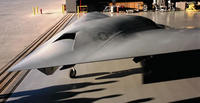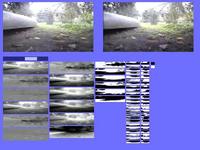-
Future UAVs will emulate birds
Engineers at UC San Diego are mimicking the movement of bird wings to help improve the maneuverability of unmanned aerial vehicles (UAVs); this is important, because UAVs are quickly becoming popular tools for the armed forces, and there are also a myriad of civilian applications which are rapidly developing, such as border control, wildfire monitoring, search and rescue, and traffic observation
-
-
DARPA crowd-source next-gen UAV design
DARPA has announced its UAVForge competition for the design of a user-intuitive, backpack-portable UAV which is also quiet, can stay aloft for at least three hours, and can fly in harsh condition; in addition to the $100,000 prize, the winning team will have the opportunity to showcase its design in an overseas military exercise
-
-
Smartphone apps help thousands in latest storms
In the recent string of natural disasters to hit the Midwest, emergency communication smartphone apps have proven invaluable for contacting family members and first responders; during these natural disasters, telephone lines and cell phone towers are often inundated with traffic, leaving individuals unable to contact their loved ones or even reach 911; thanks to smartphone apps like Life360, individuals have been able to contact family members to let them know they are okay, or alert emergency workers if they are in trouble; during the floods that left Memphis, Tennessee under water, more than 2,400 families used the app to share their locations and confirm their safety
-
-
Forensic science to foiling fakers of Chinese art

The field of Chinese art has become one of the hottest sectors of the global art market in recent years, and nowhere more so than in the demand for fine antique porcelain; prices for the finest Imperial porcelain have soared, but so have the ambitions of accomplished fakers, seeking to infiltrate exquisite new fakes into a market eager for top quality material; a joint effort by university researchers and an auction house will see the application of forensic science in the authentication of Chinese artifacts
-
-
Phantom Ray completes maiden flight

Phantom Ray, Boeing’s fighter-sized unmanned airborne system (UAS), took to the early morning skies on 27 April at Edwards Air Force Base in California for its maiden flight; Phantom Ray is one of several programs in Boeing’s Phantom Works division, including Phantom Eye, which is part of a rapid prototyping initiative to design, develop, and build advanced aircraft and then demonstrate their capabilities
-
-
Portable technology provides drinking water, power to villages, military
Researchers have developed an aluminum alloy that could be used in a new type of mobile technology to convert non-potable water into drinking water while also extracting hydrogen to generate electricity; such a technology might be used to provide power and drinking water to villages and also for military operations
-
-
Michelin developing puncture-proof tires
Michelin, the French tire manufacturer, has invented the “Tweel” which could make vehicles impervious to punctures or even explosions; The Tweel is a combination tire and wheel that infuses the best elements of both designs; the Tweel has no pneumatic rubber shell leaving nothing to deflate or puncture; the Tweel resembles a wagon wheel with polyurethane spokes and rubber for the treads, but is not entirely rigid as the spokes are flexible; despite these improvements in design, Tweels have several flaws that have kept them from being widely implemented
-
-
Homeland security solution competition
HSTV announced its Ideas for a Secure Tomorrow awards — a video competition that seeks the best ideas for improving security at both the local and national level; entries are due by 1 August 2011
-
-
Researchers develop paper that is stronger than steel
Work by Australian researchers is a step forward in the development of a material that has the potential to revolutionize the automotive, aviation, electrical, and optical industries; the composite material based on graphite that is a thin as paper and ten times stronger than steel
-
-
U.S. Air Force wants mind reading aerial drones
The U.S. Air Force is currently working with several firms to develop aerial drones that have the ability to think and anticipate a controller’s actions before it occurs; the Air Force began exploring this capability in order to avoid collisions during takeoff and landings at busy airport terminals where both manned and unmanned planes launch; to address this problem, the Air Force awarded contracts to several firms to develop predictive software that can anticipate a pilot’s reaction if a drone is flying too closely
-
-
Bird-like visual sense to help UAVs navigate in urban environments

The U.S. Office of Naval Research (ONR) has awarded researchers $4.5 million to develop a bird-sized, self-flying plane that could navigate through both forests and urban environments; the plane would be about the size of a crow, and, like a bird, would use vision to navigate, but it would use orientable propellers and not flap its wings; the drone will rely, in part, on a technology that emulates the visual system of animals called Convolutional Networks, which mimics the neural network in the mammalian visual cortex and can be trained quickly to interpret the world around it
-
-
Space technology of practical uses on Earth

Terahertz technology developed for space missions to study the most distant objects in the universe is now finding a host of practical applications back on Earth; most clothing and packaging materials are transparent to Terahertz radiation, whereas skin, water, metal and a host of other interesting materials are not; this gives rise to some important day-to-day applications: detecting weapons concealed under clothing or inside parcels; distinguishing skin and breast cancer tissue; quality control of manufactures items and processes in factories
-
-
Army spends $50M for translation app that is already available

This year the Pentagon has set aside nearly $50 million for the development of a sophisticated smartphone translation app that would allow troops in Afghanistan to translate Pastho and Dari; but some troops have already begun using the SpeechTrans app to translate Arabic which can be downloaded on any iPhone or iPad for less than $20, and the New Jersey based company is hard at work on an Afghan language edition of its app; one defense analyst questions the need to spend millions on research when “good enough” technology is already available, especially in light of congressional efforts to cut the deficit
-
-
New rifle sighting system dramatically improves accuracy
Crosshairs automatically adjust for conditions in real time; a fiber-optic laser-based sensor system automatically corrects for even tiny barrel disruptions; the system, developed at Oak Ridge National Laboratory’s (ORNL), precisely measures the deflection of the barrel relative to the sight and then electronically makes the necessary corrections; the new sensor is 250 times better than that of traditional crosshairs, which can be manually adjusted by one-fourth minutes of angle; the ORNL sensor can sense angular displacement and shift the reticle (crosshairs) by 1/1,000th of a minute of angle
-
-
Brazilian police get biometric "Robocop" glasses
Facial-recognition glasses have been deployed by Brazilian police ahead of the 2014 World Cup soccer tournament; the system can scan and compare four hundred faces per second using 46,000 biometric points for comparison; the technology will be tested at public events leading up to the World Cup
-
More headlines
The long view
Autonomous Vehicle Technology Vulnerable to Road Object Spoofing and Vanishing Attacks
Researchers have demonstrated the potentially hazardous vulnerabilities associated with the technology called LiDAR, or Light Detection and Ranging, many autonomous vehicles use to navigate streets, roads and highways. The researchers have shown how to use lasers to fool LiDAR into “seeing” objects that are not present and missing those that are – deficiencies that can cause unwarranted and unsafe braking or collisions.
Tantalizing Method to Study Cyberdeterrence
By Trina West
Tantalus is unlike most war games because it is experimental instead of experiential — the immersive game differs by overlapping scientific rigor and quantitative assessment methods with the experimental sciences, and experimental war gaming provides insightful data for real-world cyberattacks.
Prototype Self-Service Screening System Unveiled
TSA and DHS S&T unveiled a prototype checkpoint technology, the self-service screening system, at Harry Reid International Airport (LAS) in Las Vegas, NV. The aim is to provide a near self-sufficient passenger screening process while enabling passengers to directly receive on-person alarm information and allow for the passenger self-resolution of those alarms.
Falling Space Debris: How High Is the Risk I'll Get Hit?
By Zulfikar Abbany, Julia Vergin, and Katja Sterzik
An International Space Station battery fell back to Earth and, luckily, splashed down harmlessly in the Atlantic. Should we have worried? Space debris reenters our atmosphere every week.
Testing Cutting-Edge Counter-Drone Technology
Drones have many positive applications, bad actors can use them for nefarious purposes. Two recent field demonstrations brought government, academia, and industry together to evaluate innovative counter-unmanned aircraft systems.
Strengthening the Grid’s ‘Backbone’ with Hydropower
By Michael Matz
Argonne-led studies investigate how hydropower could help add more clean energy to the grid, how it generates value as grids add more renewable energy, and how liner technology can improve hydropower efficiency.
The Tech Apocalypse Panic is Driven by AI Boosters, Military Tacticians, and Movies
By Matthew Guariglia
From popular films like a War Games or The Terminator to a U.S. State Department-commissioned report on the security risk of weaponized AI, there has been a tremendous amount of hand wringing and nervousness about how so-called artificial intelligence might end up destroying the world. There is one easy way to avoid a lot of this and prevent a self-inflicted doomsday: don’t give computers the capability to launch devastating weapons.
The Tech Apocalypse Panic is Driven by AI Boosters, Military Tacticians, and Movies
By Matthew Guariglia
From popular films like a War Games or The Terminator to a U.S. State Department-commissioned report on the security risk of weaponized AI, there has been a tremendous amount of hand wringing and nervousness about how so-called artificial intelligence might end up destroying the world. There is one easy way to avoid a lot of this and prevent a self-inflicted doomsday: don’t give computers the capability to launch devastating weapons.
